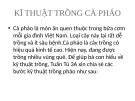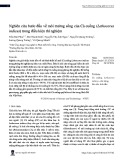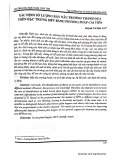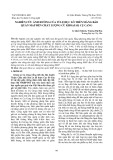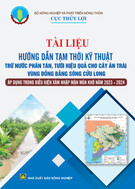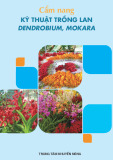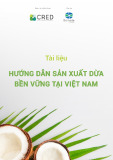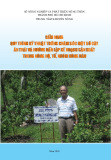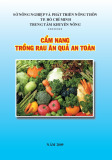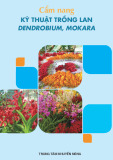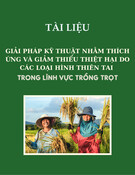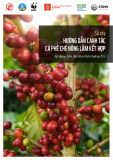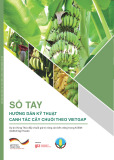Vietnam J. Agri. Sci. 2025, Vol. 23, No. 3: 279-288
Tạp chí Khoa học Nông nghiệp Việt Nam 2025, 23(3): 279-288 www.vnua.edu.vn
NH HƯỞNG CỦA MẬT ĐỘ VÀ PHƯƠNG PHÁP TRỒNG ĐẾN CỎ DẠI, SINH TRƯỞNG VÀ NĂNG SUẤT NGÔ RAU
Trần Thị Thiêm*, Nguyễn Thị Loan, Thiều Thị Phong Thu
Khoa Nông học, Học viện Nông nghiệp Việt Nam
*Tác giả liên hệ: tranthiem@vnua.edu.vn
Ngày nhận bài: 15.01.2025
Ngày chấp nhận đăng: 19.03.2025
TÓM TẮT
Nghiên cứu được thực hiện nhằm đánh giá ảnh hưởng của mật độ trồng và phương pháp trồng đến thành phần, mật độ và khối lượng chất khô của cỏ dại, cùng sinh trưởng và năng suất ngô rau. Thí nghiệm 2 nhân tố được thiết kế theo kiểu ô lớn - ô nhỏ (Split - Plot) ở vụ xuân năm 2020, tại Gia Lâm - Hà Nội, với 3 lần nhắc lại. Nhân tố ô lớn là mật độ trồng gồm 4 mức: 138.888 cây/ha (12 × 60cm); 111.111 cây/ha (15 × 60cm); 92.593 cây/ha (18 × 60cm) và 79.365 cây/ha (21 × 60cm). Nhân tố ở ô nhỏ là phương pháp trồng bao gồm trồng góc vuông (P1) và trồng nanh sấu (P2). Kết quả cho thấy, tăng mật độ trồng đã hạn chế sự sinh trưởng, phát triển của cỏ dại, đồng thời tăng năng suất bắp ngô. Tuy nhiên, phương pháp trồng góc vuông hay trồng nanh sấu không ảnh hưởng đến các chỉ tiêu sinh trưởng của cỏ cũng như sinh trưởng và năng suất ngô. Ở cùng một phương pháp trồng, tăng mật độ trồng đã làm giảm đáng kể mật độ cỏ, khối lượng chất khô của cỏ, làm tăng năng suất bắp ngô rau. Năng suất thực thu bắp đạt được cao nhất (1,69-1,77 tấn/ha) ở mật độ trồng 111.111-138.888 cây/ha khi trồng góc vuông hoặc trồng nanh sấu.
Từ khóa: Mật độ trồng, phương pháp trồng, cỏ dại, năng suất ngô rau.
Effects of Planting Density and Planting Pattern on Weed, Growth and Yield of Baby Corn
ABSTRACT
This study was conducted to evaluate the effects of planting density and planting pattern on weed species, weed density and weed biomass, growth and cob yield of baby corn. The field experiment was conducted in 2020 spring in Gia Lam, Ha Noi using a split-plot design with three replications. The main plot was planting densities with four levels: 138,888 plants ha-1, 111,111 plants ha-1, 92,593 plants ha-1, and 79,365 plants ha-1. The sub-plot factor was two planting patterns: quadrate planting and triangular planting. The results showed that increasing planting density suppressed weed growth while increasing corn yield. However, the planting patterns did not affect the weed growth as well as the growth and yield of corn. With the same planting pattern, increasing planting density significantly reduced weed density and weed biomass, and increased yield of baby corn. The highest corn yield (1.69-1.77 tons/ha) was obtained at the planting density of 111,111-138,888 plants/ha combined with quadrate planting or triangular planting.
Keywords: Planting density, planting pattern, weed, baby corn, cob yield.
1. ĐẶT VẤN ĐỀ
Ngô rau cñn đāČc gõi là ngô baby hoặc ngô bao tĄ, sĄ dĀng bíp non nhā mût loäi rau phĀc vĀ câ ën tāći và chế biến nên có giá trð hiệu quâ kinh tế cao. Ngoài ra, lāČng sinh khøi chçt xanh cþa cây ngô còn läi sau khi thu hoäch có thể làm phân bón, thăc ën xanh hoặc lên men cho gia
súc. Ngô rau có giá trð dinh dāċng cao, chăa nhiều vitamin, khoáng chçt, protein và bíp non thu hoäch Ċ giai đoän phun råu đāČc bao bõc bĊi lá bi nên sân phèm an toàn. Vĉi thĈi gian sinh trāĊng ngín và giá trð dinh dāċng cao, ngô rau đã đāČc đāa vào cć cçu cây rau để tëng vĀ trong các công thăc luân canh hoặc đāČc canh tác theo tiêu chuèn nhìm mang läi giá trð kinh tế cao.
279
Ảnh hưởng của mật độ và phương pháp trồng đến cỏ dại, sinh trưởng và năng suất ngô rau
phát triển và nëng suçt cây tr÷ng (Williams & cs., 2014; Zhang & cs., 2021; Meithasari & cs., 2023). Tuy nhiên, thông tin nghiên cău về các biện pháp kỹ thuêt canh tác bìng điều chînh mêt đû và phāćng pháp tr÷ng thích hČp để quân lý có däi, đ÷ng thĈi tëng nëng suçt ngô rau còn hän chế. Chính vì vêy, nghiên cău này đāČc thĆc hiện nhìm xác đðnh mêt đû và phāćng pháp tr÷ng phù hČp cho cây ngô rau, góp phæn hoàn thiện quy trình canh tác ngô rau an toàn, không sĄ dĀng thuøc trĂ có.
2. PHƯƠNG PHÁP NGHIÊN CỨU
2.1. Địa điểm và vật liệu
Thí nghiệm đāČc thĆc hiện Ċ vĀ xuån nëm 2020 täi khu thí nghiệm màu cþa Khoa Nông hõc, Hõc viện Nông nghiệp Việt Nam, Trâu Quč - Gia Lâm - Hà Nûi. Giøng ngô rau LVN23 (do Viện Nghiên cău Ngô chõn täo) đāČc sĄ dĀng trong nghiên cău. Phân bón sĄ dĀng là phân đäm urê Phú Mỹ (46% N), lân supe lân Lâm Thao (16% P2O5) và kali Phú Mỹ (61% K2O).
2.2. Phương pháp nghiên cứu
Có däi là mût trong nhąng nguyên nhân chính làm giâm nëng suçt cây tr÷ng. Theo Kumawat & cs. (2019), nëng suçt ngô giâm khoâng 37% do có däi gåy ra. Để quân lý có däi trên đ÷ng ruûng, sĄ dĀng thuøc trĂ có đem läi hiệu quâ trĂ có cao. Tuy nhiên, việc sĄ dĀng liên tĀc thuøc trĂ có sẽ làm tëng tính kháng thuøc cþa có däi, đ÷ng thĈi để läi t÷n dā thuøc trĂ có trong sân phèm, gây ô nhiễm möi trāĈng, ânh hāĊng đến sinh vêt hąu ích trong đçt, tëng tính kháng thuøc (Al-Samarai & cs., 2018). Nhiều nghiên cău đã chî ra rìng phân bø không gian quæn thể cây tr÷ng thông qua điều chînh mêt đû và phāćng pháp tr÷ng là yếu tø quan trõng, ânh hāĊng đến nëng suçt cây tr÷ng (Williams & cs., 2014; Zhang & cs., 2021) và sinh trāĊng cþa có däi (Hossain & cs., 2005). Theo Marin & Weiner (2014) và Youngerman & cs. (2018), tëng mêt đû tr÷ng dén đến tëng khâ nëng ăc chế có däi cþa cây tr÷ng nên sinh khøi có däi thçp. Mêt đû cây cao hćn giýp ngö cänh tranh vĉi có däi hiệu quâ hćn do quá trình khép tán nhanh và hän chế có däi tiếp xýc ánh sáng nên nëng suçt ngö tëng (Williams & cs., 2014; El-Sobky & El -Naggar, 2016). Tuy nhiên, mêt đû quá cao có thể làm giâm nëng suçt ngô. Theo Ghosh & cs. (2017), nëng suçt ngô bao tĄ đät cao nhçt Ċ mêt đû 100.000 cây/ha và giâm nhẹ Ċ mêt đû 120.000 cây/ha. Williams & cs. (2014) cho rìng nëng suçt ngô giâm Ċ mêt đû tr÷ng cao là do sø lāČng lá/cây và diện tích lá tiếp nhên ánh sáng giâm nên hoät đûng đ÷ng hóa cþa quang hČp thçp hćn. Phāćng pháp tr÷ng ânh hāĊng rõ rệt đến khâ nëng tiếp nhên ánh sáng và tøc đû quang hČp cþa cây cà chua (Zhang & cs., 2024). Kết hČp tëng mêt đû và áp dĀng phāćng pháp tr÷ng cò đû đ÷ng đều cao về không gian giúp hän chế có däi và tëng nëng suçt lúa mì (Kristensen & cs., 2008). Ở mêt đû tr÷ng 90.000 cây/ha, tr÷ng nanh sçu hàng kết hČp làm đçt lên luøng đã cho nëng suçt ngô hät trong câ vĀ xuân và vĀ hè cao hćn so vĉi tr÷ng góc vuông khöng làm đçt (Sun & cs., 2023).
Việc bø trí quæn thể ruûng cây tr÷ng tøi āu bìng cách điều chînh mêt đû và phāćng pháp gieo tr÷ng có thể ânh hāĊng đến khâ nëng cänh tranh giąa có däi và cây tr÷ng, sĆ sinh trāĊng,
Thí nghiệm 2 nhân tø đāČc bø trí theo kiểu ô lĉn - ô nhó (Split - Plot) vĉi 3 læn nhíc läi. Trong đò nhån tø ô lĉn là mêt đû tr÷ng vĉi 4 măc: M1: 138.888 cây/ha (12 × 60cm); M2: 111.111 cây/ha (15 × 60cm); M3: 92.593 cây/ha (18 × 60cm) và M4: 79.365 cây/ha (21 × 60cm). Nhân tø ô nhó là phāćng pháp tr÷ng bao g÷m tr÷ng góc vuông (P1) và tr÷ng nanh sçu (P2) (Hình 1). Thí nghiệm g÷m 8 tù hČp công thăc vĉi 3 læn nhíc läi. Diện tích múi ô thí nghiệm 10m2, chiều dài múi ô là 10m và chiều rûng là 1m, múi luøng tr÷ng hai hàng ngô vĉi khoâng cách là 60cm. Hät giøng ngö đāČc gieo trong bæu có giá thể là đçt, cát và phân gà trong 2 tuæn. Cây con có 2-3 lá đāČc tr÷ng ra ruûng theo mêt đû và phāćng pháp tr÷ng nhā trên. LāČng phân bón cho 1ha là 120kg N, 60 kg P2O5, 60kg K2O. Toàn bû phân lân, 30% N và 30% K2O đāČc bón lót trāĉc khi tr÷ng. Bón thúc læn 1 sau tr÷ng 10-15 ngày vĉi lāČng 20% N và 20% K2O. Bón thúc læn 2 sau tr÷ng 25-30 ngày vĉi lāČng 30% N và 40% K2O. Bón thúc læn 3 sau tr÷ng 35 ngày vĉi lāČng 20% N và 10% K2O.
280
Trần Thị Thiêm, Nguyễn Thị Loan, Thiều Thị Phong Thu
O O O O O O
O O
O O O O O O
O O
O O O O O O
O O
O O O O O O
O O
O O O O O O
O O
O O O O O O
O O
Trồng góc vuông (P1) Trồng nanh sấu (P2)
Hình 1. Phương pháp trồng ngô góc vuông và trồng nanh sấu
2.3. Chỉ tiêu theo dõi
chiều rûng lá × 0,75 × sø lá/cây. Sau khi xác đðnh diện tích lá, toàn bû khøi lāČng cåy đāČc đem sçy Ċ nhiệt đû 80C đến khøi lāČng không đùi để xác đðnh khøi lāČng khô cþa ngô. Sau tr÷ng 42-45 ngày, tiến hành thu hoäch bíp non, múi đČt thu hoäch cách nhau 3-5 ngày. Các chî tiêu về các yếu tø cçu thành nëng suçt nhā khøi lāČng bíp, sø bíp/cåy đāČc tính trên 5 cây/ô thí nghiệm. Nëng suçt thĆc thu bíp tāći đāČc tính trên toàn bû sø cây có trên ruûng thí nghiệm và quy đùi ra đćn vð tçn/ha.
2.4. Xử lý số liệu
Sø liệu đāČc tùng hČp, phân tích thøng kê cć bân và phån tích phāćng sai (ANOVA) hai nhån tø bìng phæn mềm Minitab 16 và Excel. So sánh sĆ sai khác giąa mêt đû gieo, phāćng phāćng tr÷ng và sĆ tāćng tác cþa hai nhân tø dĆa trên kiểm đðnh Tukey Ċ đû tin cêy 95%.
Thành phæn có däi và tæn suçt xuçt hiện có däi trên ruûng thí nghiệm đāČc xác đðnh khi cây ngô trú cĈ và thu hoäch bíp, phāćng pháp xác đðnh theo Nguyễn Thð Tân & Nguyễn H÷ng Sćn (1997). Múi ô thí nghiệm điều tra 5 điểm, múi điểm điều tra trong khung ô vuông có diện tích 0,25m2 (50cm × 50cm). Măc đû phù biến cþa các loài có đāČc xác đðnh theo thang 4 cçp. Tæn suçt xuçt hiện nhó hćn 10% (+); 10-30% (++); 30-50% (+++) và lĉn hćn 50% (++++). Có däi đāČc thu thêp cho vào túi riêng cò đánh sø, sau đò phån loäi, nhên diện thành phæn có däi dĆa vào đặc điểm thĆc vêt hõc (Dāćng Vën Chín & cs., 2022). Mêt đû có däi (cây/m2) đāČc xác đðnh bìng cách đếm sø lāČng cây có däi Ċ múi ô thí nghiệm. Sau khi xác đðnh thành phæn và mêt đû, có đāČc đem sçy Ċ nhiệt đû 80C đến khøi lāČng khöng đùi để xác đðnh khøi lāČng khô có.
3. KẾT QUẢ VÀ THẢO LUẬN
3.1. Ảnh hưởng của mật độ và phương pháp
trồng đến thành phần, mật độ và khối
lượng chất khô của cỏ dại
Thành phæn có däi đều xuçt hiện giøng nhau Ċ tçt câ công thăc, bao g÷m có gçu (Cyperus rotundus L.), mæn træu (Eleusine indica (L.) Gaertn.), có đuöi phĀng (Leptochloa
Chiều cao cåy (đo tĂ gøc cho đến mút lá dài nhçt), sø lá trên cây (tính tĂ lá thêt đæu tiên đến lá trên cüng) đāČc xác đðnh trên 5 cây/ô thí nghiệm. Diện tích lá, khøi lāČng chçt khö đāČc xác đðnh Ċ 3 thĈi kč (7-9 lá, trú cĈ và thu hoäch læn cuøi), Ċ múi thĈi kč lçy méu 3 cây/ô thí nghiệm cho múi læn nhíc läi. Chî sø diện tích lá (LAI) đāČc tính bìng diện tích lá/đćn vð diện tích đçt, trong đò diện tích lá = chiều dài lá ×
281
Ảnh hưởng của mật độ và phương pháp trồng đến cỏ dại, sinh trưởng và năng suất ngô rau
có
có
cän l÷ng vĆc chinensis (L.) Nees), (L.) Link), có mĆc (Echinochloa colonum (Eclipta alba chân gà (L.) Hassk), (Dactyloctenium aegyptium (L.) Willd). Trong các thành phæn có däi, có mæn træu, có gçu, có
đuöi phĀng và l÷ng vĆc cän xuçt hiện nhiều nhçt (Bâng 1). Kết quâ nghiên cău cþa Vu & Ha (2015) cÿng khîng đðnh trên ruûng ngô, các loài có phát triển mänh bao g÷m có mæn træu, có đuöi phĀng, có gà.
Bâng 1. Ảnh hưởng của mật độ
và phương pháp trồng đến thành phần cỏ dại và tần suất xuất hiện cỏ dại
Lồng vực cạn Mần trầu Đuôi phụng Cỏ chân gà Cỏ mực Cỏ gấu
Ghi chú: +: Tần suất xuất hiện nhỏ hơn 10%; ++: Tần suất xuất hiện 10-30%; +++: Tần suất xuất hiện 30-50%; ++++: Tần suất xuất hiện lớn hơn 50%.; M1: 138.888 cây/ha, M2: 111.111 cây/ha, M3: 92.593 cây/ha và M4: 79.365 cây/ha; P1: trồng góc vuông, P2: trồng nanh sấu.
Công thức Cyperus rotundus (L.) Echinochloa crus-galli (L.) Link Eleusine indica (L.) Gaertn Leptochloa chinensis (L.) Nees Dactyloctenium aegyptium (L.) Willd Eclipta alba (L.) Hassk P1M1 ++ +++ + + + ++ P1M2 ++ ++ + + + ++ P1M3 ++ ++ ++ + + ++ P1M4 ++ ++ ++ + ++ P2M1 ++ +++ + + + + P2M2 + ++ ++ + + ++ P2M3 ++ +++ ++ + + + P2M4 ++ +++ ++ + + +
Bâng 2. Ảnh hưởng của mật độ và phương pháp trồng đến mật độ và khối lượng chất khô cỏ dại
Ghi chú: Trong cùng một cột, các chữ cái khác nhau thể hiện sự không sai khác có ý nghĩa thống kê theo kiểm định Tukey ở độ tin cậy 95%; M1: 138.888 cây/ha, M2: 111.111 cây/ha, M3: 92.592 cây/ha và M4: 79.365 cây/ha; P1: trồng góc vuông, P2: trồng nanh sấu.
Yếu tố thí nghiệm Mật độ (cây/m2) Khối lượng tươi (g/m2) Khối lượng chất khô (g/m2) Phương pháp trồng (P) 442,4 104,3 P1 260,7 459,3 106,6 P2 270,3 ANOVA (P) M1 Mật độ (M) M2 M3 ns 389,2b 395,3b 447,0b 571,8a ns 85,2b 106,8ab 97,1b 132,9a M4 ns 260,0ab 230,0b 282,0a 290,0a ANOVA (M) M1 P1 M2 M3 M4 M1 P2 M2 M3 * 442,2b 355,1c 430,8b 541,4a 336,3c 435,4b 463,1b 602,3a * 82,1c 122,4ab 85,7c 127,1ab 88,2c 91,2c 108,5bc 138,6a M4 * 266,7b 252,0bc 233,3c 290,7ab 253,3bc 208,0c 330,7a 289,3ab * * * ANOVA (P&M)
282
Trần Thị Thiêm, Nguyễn Thị Loan, Thiều Thị Phong Thu
phāćng pháp tr÷ng đến các chî tiêu có däi cho thçy có sĆ sai khác cò Ď nghïa thøng kê giąa các công thăc khác nhau. Tr÷ng mêt đû dày kết hČp tr÷ng góc vuông hay vĉi phāćng pháp tr÷ng nanh sçu đều hän chế sĆ sinh trāĊng cþa có däi so vĉi tr÷ng Ċ mêt đû thāa. P1M4, P2M3 và P2M4 cho mêt đû có cao nhçt (289,3-330,7 g/m2), thçp nhçt Ċ công thăc P1M3, P2M1 và P2M2 (208,0-252,0 g/m2). Tāćng tĆ, khøi lāČng chçt khô cþa có cao nhçt Ċ P1M4 và P2M4 (127,1-138,6 g/m2), thçp nhçt Ċ P1M1 và P2M1 (82,1-85,7 g/m2).
3.2. Ảnh hưởng của mật độ và phương pháp trồng đến một số chỉ tiêu sinh trưởng
ngô rau
Mêt đû có và khøi lāČng chçt khô cþa có không có sĆ sai khác cò Ď nghïa thøng kê dāĉi tác đûng cþa phāćng pháp tr÷ng khác nhau. Hossain & cs. (2005) cÿng kết luên khøi lāČng khô cþa có không khác biệt khi tr÷ng cây nghệ theo góc vuông hay tr÷ng nanh sçu. Trong khi đò, mêt đû tr÷ng khác nhau có ânh hāĊng đến mêt đû có, khøi lāČng tāći và khøi lāČng khô cþa có Ċ măc cò Ď nghïa thøng kê (Bâng 2). Nhìn chung, khi tëng mêt đû tr÷ng ngö đã làm giâm mêt đû có dén đến giâm khøi lāČng có và có sĆ sai khác cò Ď nghïa thøng kê. Điều này là do khi tr÷ng Ċ mêt đû dày hćn, tán cây khép nhanh hćn, làm giâm khâ nëng tiếp nhên ánh sáng cþa có däi, do đò ăc chế sĆ phát triển cþa có däi. Các nghiên cău trāĉc đåy cÿng cho thçy mêt đû và khøi lāČng khô cþa có giâm mänh khi tëng mêt đû tr÷ng cþa cây diêm mäch (Hanif & cs., 2024), cåy đêu (Kebede & cs., 2015) và cây ngô rau (Tran & cs., 2020).
Kết quâ bâng 3 cho thçy, thĈi gian tĂ tr÷ng đến thu hoäch ngô rau không bð ânh hāĊng bĊi mêt đû và phāćng pháp tr÷ng (dao đûng tĂ 54-57 ngày).
Khi xét ânh hāĊng tāćng tác cþa mêt đû và
Bâng 3. Ảnh hưởng của mật độ và phương pháp trồng đến thời gian từ trồng đến thu hoạch, chiều cao cây và số lá của ngô rau
Yếu tố thí nghiệm Thời gian từ trồng đến thu hoạch (ngày) Chiều cao cây (cm) Số lá (lá/cây)
Phương pháp trồng (P) P1 - 164,2 15,7
P2 - 163,2 15,9
- ns ns ANOVA (P) M1 Mật độ (M) - 170,5a 15,7
M2 - 164,4ab 15,7
M3 - 160,2b 16,0
M4 - 159,8b 15,8
- * ns ANOVA (M) M1 P1 54 171,5a 15,7
M2 54 164,1ab 15,3
M3 56 159,5b 16,1
M4 55 161,7b 15,7
M1 P2 56 170,4a 15,7
M2 57 164,8ab 16,0
M3 54 160,8b 15,9
M4 55 157,9b 16,0
Ghi chú: Trong cùng một cột, các chữ cái khác nhau thể hiện sự không sai khác có ý nghĩa thống kê theo kiểm định Tukey ở độ tin cậy 95%; M1: 138.888 cây/ha, M2: 111.111 cây/ha, M3: 92.592 cây/ha và M4: 79.365 cây/ha; P1: trồng góc vuông, P2: trồng nanh sấu.
- * ns ANOVA (P&M)
283
Ảnh hưởng của mật độ và phương pháp trồng đến cỏ dại, sinh trưởng và năng suất ngô rau
Bâng 4. Ảnh hưởng của mật độ và phương pháp trồng đến chỉ số diện tích lá và khối lượng chất khô của ngô rau
Chỉ số diện tích lá (m2 lá/m2 đất) Khối lượng chất khô (g/m2) Yếu tố thí nghiệm 7-9 lá Trỗ cờ Thu hoạch 7-9 lá Trỗ cờ Thu hoạch
Phương pháp trồng (P) P1 1,0 3,1 2,9 36,9 331,1 480,8
P2 1,0 3,2 3,1 35,1 320,7 472,4
ns ns ns ns ns ns ANOVA (P) Mật độ (M) M1 1,3a 3,8a 3,6a 46,9a 396,2a 603,3a
M2 1,0b 3,6a 3,3b 39,1a 342,7b 500,6b
M3 0,9c 2,9b 2,8c 30,9b 302,9bc 427,8c
M4 0,7d 2,4c 2,3d 27,2b 261,9c 374,7d
* * * * * * ANOVA (M) P1 M1 1,3a 3,8a 3,5a 48,4a 401,1a 605,7a
M2 1,0c 3,6a 3,2a 39,5ab 355,1bc 503,7b
M3 0,9d 2,8bc 2,7b 32,1bc 298,2de 435,2c
M4 0,7e 2,3d 2,1c 27,5c 269,9ef 378,4d
P2 M1 1,2b 3,8a 3,7a 45,3a 391,3ab 600,8a
M2 1,0c 3,6a 3,4a 38,6ab 330,2cd 497,5b
M3 0,9d 3,1b 2,9b 29,8bc 307,5de 420,3c
M4 0,7e 2,5cd 2,3c 26,8c 253,9f 371,0d
Ghi chú: Trong cùng một cột, các chữ cái khác nhau thể hiện sự không sai khác có ý nghĩa thống kê theo kiểm định Tukey ở độ tin cậy 95%; M1: 138.888 cây/ha, M2: 111.111 cây/ha, M3: 92.593 cây/ha và M4: 79.365 cây/ha; P1: trồng góc vuông, P2: trồng nanh sấu.
Sø lá ngö cÿng tëng dæn theo thĈi gian sinh trāĊng và không bð ânh hāĊng bĊi phāćng pháp tr÷ng và mêt đû tr÷ng khác nhau Ċ đû tin cêy 95%. Sø lá ngö thāĈng do đặc tính cþa giøng quyết đðnh, ít khi bð thay đùi bĊi các điều kiện canh tác. Nguyễn Quøc Mänh & cs. (2020) cÿng khîng đðnh sø lá trên cùng mût giøng ngô không thay đùi khi tr÷ng Ċ các mêt đû khác nhau.
* * * * * * ANOVA (P&M)
3.3. Ảnh hưởng của mật độ và phương pháp trồng đến chỉ số diện tích lá và khâ năng tích luỹ chất khô của ngô rau
Kết quâ bâng 4 cho thçy, chî sø diện tích lá (LAI) cþa cåy ngö tëng dæn tĂ thĈi kč 7-9 lá và đät giá trð cĆc đäi vào thĈi kč trú cĈ, sau đò cò xu hāĉng giâm nhẹ Ċ thĈi kč thu hoäch. LAI không có sĆ sai khác cò Ď nghïa thøng kê giąa phāćng pháp tr÷ng góc vuông và tr÷ng nanh sçu Ċ tçt câ các thĈi kč theo dõi. Tuy nhiên, mêt đû
Chiều cao cåy ngö rau tëng dæn theo thĈi gian sinh trāĊng và có sĆ ânh hāĊng khác nhau bĊi mêt đû và phāćng pháp tr÷ng ngô (Bâng 3). CĀ thể, chiều cao cây cuøi cùng không có sĆ sai khác cò Ď nghïa giąa tr÷ng góc vuông và tr÷ng nanh sçu, nhāng mêt đû tr÷ng khác nhau có ânh hāĊng đến chiều cao cây ngô Ċ măc có ý nghïa thøng kê. Tr÷ng dày Ċ mêt đû M1 và M2 làm tëng chiều cao cây ngô so vĉi mêt đû tr÷ng thāa M3 và M4. Chiều cao cåy ngö rau cÿng bð ânh hāĊng tāćng tác bĊi mêt đû tr÷ng và phāćng pháp tr÷ng Ċ măc có ý nghïa thøng kê. Ở mêt đû tr÷ng 14 cây/m2 kết hČp vĉi phāćng pháp tr÷ng góc vuông hay tr÷ng nanh sçu hàng đều cho chiều cao cây ngô rau (170,4-171,5cm) cao hćn các măc mêt đû tr÷ng 8-9 cây/m2 kết hČp vĉi phāćng pháp tr÷ng (157,9-161,7cm) Ċ đû tin cêy 95%. Chiều cao cåy tëng khi tëng mêt đû tr÷ng là do sĆ cänh tranh giąa các cây tr÷ng về ánh sáng nên cây có xu hāĉng vāćn cao.
284
Trần Thị Thiêm, Nguyễn Thị Loan, Thiều Thị Phong Thu
P2M4) cho khøi lāČng chçt khô thçp nhçt (253,9-269,9 g/m2). Li & cs. (2019) cÿng khîng đðnh khøi lāČng khô cþa thân lá ngô (tính trên đćn vð diện tích) tëng khi tëng mêt đû tr÷ng. Tuy nhiên, khi mêt đû tr÷ng vāČt quá mêt đû tr÷ng thích hČp có thể làm giâm khâ nëng tích lÿy chçt khô cþa ngô do sĆ cänh tranh mänh mẽ về điều kiện søng giąa các cåy ngö trên đ÷ng ruûng (Raymond & cs., 2009). Theo Meithasari & cs. (2023), tr÷ng ngô góc vuông Ċ mêt đû cao có thể tích lÿy lāČng vêt chçt khö tāćng đāćng vĉi khi tr÷ng nanh sçu.
3.4. Ảnh hưởng của mật độ và phương pháp
trồng đến các yếu tố cấu thành năng suất và năng suất ngô rau
tr÷ng khác nhau có ânh hāĊng rçt rô đến LAI Ċ câ 3 thĈi kč theo dôi. LAI tëng khi mêt đû tëng, đät cao nhçt Ċ mêt đû M1 và thçp nhçt Ċ mêt đû M4. Khi xét ânh hāĊng tāćng tác giąa mêt đû tr÷ng và phāćng pháp tr÷ng đến LAI Ċ tĂng thĈi kč theo dõi cho thçy, Ċ câ phāćng thăc tr÷ng góc vuông và tr÷ng nanh sçu kết hČp mêt đû tr÷ng càng cao cho LAI càng cao. Lê Thð Nghiêm & cs. (2017); Li & cs. (2019) cÿng khîng đðnh LAI cþa ngö tëng khi tr÷ng Ċ mêt đû dày hćn. NgāČc läi, mêt đû tr÷ng thçp kết hČp vĉi tr÷ng góc vuông và tr÷ng nanh sçu đều cho LAI thçp. CĀ thể, Ċ thĈi kč 7-9 lá, LAI dao đûng tĂ 0,7-1,3m2 lá/m2 đçt, công thăc có LAI cao nhçt P1M1 (1,3m2 lá/m2 đçt), công thăc có LAI thçp nhçt P2M4 (0,7m2 lá/m2 đçt). Ở thĈi kč trú cĈ, LAI đät giá trð cao nhçt täi công thăc P1M1 và P2M1 (3,8 m2 lá/m2 đçt), thçp nhçt täi công thăc P1M4 và P2M4 (2,3-2,5m2 lá/m2 đçt). Tāćng tĆ, Ċ thĈi kč thu hoäch, LAI đät cao nhçt täi P1M1và P2M1 vĉi 3,5-3,7m2 lá/m2 đçt, thçp nhçt täi P14 và P2M4 vĉi 2,1-2,3m2 lá/m2 đçt
Tāćng tĆ LAI, khøi lāČng chçt khö cÿng tëng dæn theo thĈi gian sinh trāĊng cþa cây và có bð ânh hāĊng bĊi mêt đû tr÷ng và phāćng pháp tr÷ng (Bâng 4). Câ 3 giai đoän theo dõi, phāćng pháp tr÷ng không ânh hāĊng đến khøi lāČng chçt khô cþa cây ngô rau Ċ măc cò Ď nghïa thøng kê. Hossain & cs. (2005) cÿng kết luên khi tr÷ng Ċ cùng mêt đû, bø trí tr÷ng góc vuông và tr÷ng nanh sçu đều cho khøi lāČng khô cþa thân lá cây nghệ không khác biệt. Tuy nhiên, mêt đû tr÷ng có ânh hāĊng đến khøi lāČng chçt khô cþa cåy ngö rau và cò xu hāĉng tëng khi mêt đû tr÷ng tëng. Cò sĆ sai khác cò Ď nghïa thøng kê giąa mêt đû tr÷ng về khøi lāČng chçt khô Ċ câ ba thĈi kč theo dõi. Tr÷ng Ċ mêt đû dày (M1) cho khøi lāČng chçt khô cao nhçt, thçp nhçt Ċ mêt đû tr÷ng thāa (M4). Ở câ ba giai đoän theo dõi, có sĆ ânh hāĊng tāćng tác giąa mêt đû và phāćng pháp tr÷ng đến khøi lāČng chçt khô cþa ngô rau Ċ măc có Ď nghïa thøng kê. Tr÷ng góc vuông hay tr÷ng nanh sçu kết hČp vĉi tr÷ng Ċ mêt đû 14 cây/m2 (P1M1 hay P2M1) cho khøi lāČng chçt khô cao nhçt (391,3-401,1 g/m2), Ċ mêt đû tr÷ng 8 cây/m2 kết hČp vĉi tr÷ng góc vuông hay tr÷ng nanh sçu (P1M4 hay
Kết quâ phân tích thøng kê ânh hāĊng cþa mêt đû và phāćng pháp tr÷ng đến các yếu tø cçu thành nëng suçt và nëng suçt bíp ngö rau đāČc trình bày Ċ bâng 5. Kết quâ cho thçy, phāćng pháp gieo tr÷ng không ânh hāĊng đến sø lāČng bíp cÿng nhā khøi lāČng bíp, dén đến không có sĆ sai khác cò Ď nghïa thøng kê về nëng suçt chçt xanh cÿng nhā nëng suçt bíp. Hossain & cs. (2005) cÿng cho rìng, khi tr÷ng Ċ cùng mêt đû, tr÷ng nanh sçu cho nëng suçt cþ nghệ cao hćn so vĉi tr÷ng gòc vuöng nhāng khöng cò sĆ sai khác cò Ď nghïa. Trong khi đò, mêt đû tr÷ng khác nhau không ânh hāĊng đến khøi lāČng bíp nhāng cò ânh hāĊng đến sø bíp/ha Ċ măc có ý nghïa thøng kê. Tr÷ng Ċ mêt đû 138.888 cây/ha (M1) cho sø bíp cao nhçt và có sĆ sai khác có ý nghïa thøng kê so vĉi các mêt đû tr÷ng thçp hćn (79.365-111.111 cây/ha). Do mêt đû tr÷ng dày cho sø bíp/ha cao nên dén đến nëng suçt thĆc thu cÿng cao nhçt täi mêt đû M1, M2 và cao hćn cò Ď nghïa thøng kê so vĉi M3 và M4. Li &cs. (2019) cÿng kết luên nëng suçt ngö tëng khi tëng mêt đû tr÷ng. Tëng sø lāČng cây tr÷ng trên mût đćn vð diện tích sẽ làm tëng nëng suçt cây tr÷ng, tuy nhiên nếu mêt đû tr÷ng quá cao sẽ làm giâm hiệu quâ quang hČp cþa tán cây, tëng sĆ cänh tranh về điều kiện søng giąa các cây tr÷ng trên đ÷ng ruûng và làm giâm nëng suçt cây tr÷ng (Lu & cs., 2024, Zhang & cs., 2021). Bên cänh đò, tëng mêt đû tr÷ng cÿng ăc chế sĆ phát triển cþa có däi (Bâng 2), làm giâm sĆ
285
Ảnh hưởng của mật độ và phương pháp trồng đến cỏ dại, sinh trưởng và năng suất ngô rau
cänh tranh giąa có däi - cây tr÷ng, do đò cåy tr÷ng sĄ dĀng nāĉc, dinh dāċng hiệu quâ hćn, dén đến kích thích sinh trāĊng (Bâng 3), tëng khâ nëng tích luỹ chçt khô (Bâng 4), kết quâ làm tëng nëng suçt ngô (Bâng 5). Điều này cÿng đāČc khîng đðnh trong nghiên cău cþa Kebede & cs. (2015) và Hanif & cs. (2024).
(411,9-415,9 bíp/ha), thçp nhçt Ċ mêt đû tr÷ng 8 cây/m2 kết hČp vĉi tr÷ng góc vuông hay tr÷ng nanh sçu (237,5-248,1 bíp/ha). Tāćng tĆ, Ċ cùng mût phāćng pháp tr÷ng, việc tëng mêt đû tr÷ng đã làm tëng nëng suçt chçt xanh và nëng suçt bíp và có sĆ sai khác cò Ď nghïa giąa các công thăc. Nëng suçt chçt xanh đät cao nhçt Ċ mêt đû tr÷ng tĂ 111.111-138.888 cây/ha kết hČp vĉi phāćng pháp tr÷ng góc vuông hay tr÷ng nanh sçu (dao đûng tĂ 19,82-21,18 tçn/ha). Nëng suçt bíp thĆc thu tëng khi tëng mêt đû tr÷ng kết hČp vĉi tr÷ng góc vuông hay tr÷ng nanh sçu. Mêt đû tr÷ng tĂ 111.111-138.888 cây/ha kết hČp vĉi phāćng pháp tr÷ng góc vuông hay tr÷ng nanh sçu cho nëng suçt thĆc thu bíp cao nhçt, dao đûng tĂ 1,69-1,77 tçn/ha, tuy nhiên không có sĆ sai khác cò Ď nghïa thøng kê giąa tr÷ng Ċ mêt đû 138.888 cây/ha và mêt đû 111.111 cây/ha.
Xét ânh hāĊng tāćng tác cþa mêt đû tr÷ng và phāćng pháp tr÷ng đến các chî tiêu nëng suçt cho thçy, khøi lāČng bíp không bð ânh hāĊng tāćng tác bĊi mêt đû tr÷ng và phāćng pháp tr÷ng Ċ măc cò Ď nghïa thøng kê, khøi lāČng bíp khöng lá bi dao đûng tĂ 9,1-11,1 g/bíp. Tuy nhiên, sø bíp/ha, nëng suçt chçt xanh và nëng suçt thĆc thu bð ânh hāĊng cþa tāćng tác giąa mêt đû và phāćng pháp tr÷ng Ċ măc đû tin cêy 95%. Tr÷ng Ċ mêt đû 138.888 cây/ha kết hČp vĉi tr÷ng góc vuông hay tr÷ng nanh sçu (P1M1 hay P1M2) cho sø bíp/ha luôn cao nhçt
Bâng 5. Ảnh hưởng của mật độ và phương pháp trồng đến các yếu tố cấu thành năng suất và năng suất ngô rau
Yếu tố thí nghiệm Số bắp (nghìn bắp/ha) Khối lượng bắp không lá bi (g) Năng suất chất xanh (tấn/ha) Năng suất bắp thực thu (tấn/ha)
Phương phương trồng (P) P1 315,5 10,1 18,41 1,63
P2 313,7 9,5 19,40 1,69
ns ns ns ns ANOVA (P)
Mật độ trồng M1 413,9a 10,0 20,50a 1,77a (M) M2 319,9b 9,6 19,32ab 1,71a
M3 281,7c 10,3 18,36bc 1,63b
M4 242,8d 9,5 17,45c 1,54b
* ns * * ANOVA (M)
M1 415,9a P1 10,6 19,82b 1,78a
M2 318,5bcd 9,7 18,47c 1,69ab
M3 279,3de 11,1 18,26c 1,56c
M4 248,1ef 9,1 17,09d 1,54c
M1 411,9a P2 9,4 21,18a 1,77a
M2 321,12bc 9,4 20,17ab 1,77a
M3 284.0cde 9,4 18,46c 1,64bc
M4 237,5f 9,8 17,81cd 1,55c
Ghi chú: Trong cùng một cột, các chữ cái khác nhau thể hiện sự không sai khác có ý nghĩa thống kê theo kiểm định Tukey ở độ tin cậy 95%; M1: 138.888 cây/ha, M2: 111.111 cây/ha, M3: 92.592 cây/ha và M4: 79.365 cây/ha; P1: trồng góc vuông, P2: trồng nanh sấu.
* ns * * ANOVA (P&M)
286
Trần Thị Thiêm, Nguyễn Thị Loan, Thiều Thị Phong Thu
4. KẾT LUẬN
Kebede M., Sharma J.J., Tana T. & Nigatu L. (2015). Effect of plant spacing and weeding frequency on weed infestation, yield components, and yield of common bean (Phaseolus vulgaris L.) in Eastern Ethiopia. East African Journal of Sciences. 9(1): 1-14.
Kristensen L., Olsen J. & Weiner J. (2008). Crop density, sowing pattern, and nitrogen fertilization effects on weed suppression and yield in spring wheat. weed science. 56(1): 97-102.
Kumawat N., Yadav R.K., Bangar K.S., Tiwari S.C., Morya J. & Kumar R. (2019). Studies on integrated weed management practices in maize-A review. Agricultural Reviews. 40(1): 29-36.
Mêt đû tr÷ng có ânh hāĊng đến mêt đû có, khøi lāČng chçt tāći và khö cþa có, do đò cò ânh hāĊng đến các chî tiêu sinh trāĊng, sinh lý và nëng suçt bíp ngö rau. Tuy nhiên, phāćng pháp tr÷ng không ânh hāĊng đến các chî tiêu sinh trāĊng cþa có cÿng nhā sinh trāĊng cþa cây ngô và nëng suçt ngô. Ở cüng phāćng pháp tr÷ng góc vuông hay tr÷ng nanh sçu, tëng mêt đû tr÷ng đã làm giâm đáng kể mêt đû có, khøi làm lāČng chçt khô cþa có, nhāng tëng nëng suçt bíp ngô rau. Tr÷ng Ċ mêt đû 111.111-138.888 cây/ha kết hČp vĉi phāćng pháp tr÷ng góc vuông hay tr÷ng nanh sçu đã hän chế sĆ sinh trāĊng và phát triển cþa có, đ÷ng thĈi cho nëng suçt thĆc thu bíp cao nhçt (1,69-1,77 tçn/ha).
TÀI LIỆU THAM KHẢO
Lê Thị Nghiêm, Nguyễn Phước Trung, Nguyễn Phương, Dương Thị Hồng Diệu, & Võ Hoàng Nhân. (2017). Ảnh hưởng của giống, khoảng cách trồng đến năng suất bắp sinh khối trên vùng đất xám tại thành phố Hồ Chí Minh. Tạp Chí Khoa Học Trường Đại Học An Giang. 18(6): 28-36. Li Q., Kong F., Long W., Wu Y., Cheng Q., Dou P., Ma X., Yuan J. & Guo X. (2019). Effects of planting density and cropping pattern on the dry matter accumulation and yield of maize (Zea Mays L.) in southwest China. The Journal of Animal & Plant Sciences. 29(1): 182-193.
herbicides
natural
using
effect. Annals
Al-Samarai G.F., Mahdi W.M. & Al-Hilali B.M. (2018). Reducing environmental pollution by plant chemical of derivatieves allelopathy Agricultural and Environmental Medicine. 25(3): 449-452.
Lu Y., Ma R., Gao W., You Y., Jiang C., Zhang Z., Kamran M. & Yang X. (2024). Optimizing the nitrogen application rate and planting density to improve dry matter yield, water productivity and N-use efficiency of forage maize in a rainfed region. Agricultural Water Management. 305. Marin C. & Weiner J. (2014). Effects of density and sowing pattern on weed suppression and grain yield in three varieties of maize under high weed pressure. Weed Research. 54(5): 467-474.
Dương Văn Chín, Suk Jin Koo, Hoàng Việt, Hồ Lệ Thi, Đỗ Thị Kiều Anh, Trần Vũ Phến, Nguyễn Xuân Hoà, Hà Thị Thanh Bình, Vũ Duy Hoàng, Nguyễn Vĩnh Tường & Nguyễn Văn Liêm (2022). Cỏ dại phổ biến tại Việt Nam (Xuất bản lần 3). Nhà xuất bản Nông nghiệp.
El-Sobky E.E.A. & El-Naggar N.Z.A. (2016). Effect of weed control treatment and planting density in Maize (Zea mays L.). Egyptian Journal of Agronomy. 38(1): 55-77.
Meithasari D., Endriani W.W., Suretno N.D. & Tambunan R.D. (2023). Corn (Zea mays L.) productivity in acid dry land used zigzag planting method. IOP Conference Series: Earth and Environmental Science. 1172(1).
Ghosh M., Maity S.K., Gupta S.K. & Chowdhury A.R. (2017). Performance of baby corn under different plant densities and fertility levels in lateritic soils of eastern India. International Journal of Pure and Applied Bioscience. 5(3): 696-702.
Nguyễn Hồng Sơn & Nguyễn Thị Tân (1999). Phương pháp điều tra, đánh giá sâu, bệnh hại cây trồng và cỏ dại trên lúa. Trong tuyển tập: Phương pháp nghiên cứu bảo vệ thực vật. Nhà xuất bản Nông nghiệp, Hà Nội, Việt Nam. tr. 44-49
(2024). Enhancing
productivity
Hanif M.K., Afzal I., Munir M.K., Khaliq A. & Asghar H.N. and profitability of quinoa through optimization of plant spacing and weeding regimes. Field Crops Research, 315.
Nguyễn Quốc Mạnh, Hà Văn Giới, Đào Hữu Hoàng, Dương Minh Vương, Nguyễn Mạnh Hùng, & Đào Ngọc Ánh (2020). Nghiên cứu xác định mật độ trồng phù hợp cho một số giống ngô sinh khối tại tỉnh Quảng Bình. Tạp chí Khoa học Công nghệ Nông nghiệp Việt Nam. 4(113): 36-39.
Hossain M.A., Ishimine Y., Motomura K. & Akamine H. (2005). Effects of planting pattern and planting distance on growth and yield of turmeric (Curcuma longa L.). Plant Production Science. 8(1): 95-105.
Raymond F.D., Alley M.M., Parrish D.J. & Thomason W.E. (2009). Plant density and hybrid impacts on
287
Ảnh hưởng của mật độ và phương pháp trồng đến cỏ dại, sinh trưởng và năng suất ngô rau
corn grain and forage yield and nutrient uptake. Journal of Plant Nutrition. 32(3): 395-409.
D.L. (2014). Weed control and corn (Zea mays L.) response to planting pattern and herbicide program with high seeding rates in North Carolina. Advances in Agriculture. 4: 1-8.
practices
for
Sun X., Li X., Jiang W., Zhao M., Gao Z., Ge J., Sun Q., Ding Z. & Zhou B. (2023). Integrated management canopy–topsoil improves the grain yield of maize with high planting density. Plants. 12: 2000.
Tran T.T., Thu T.T.P. & Loan N.T. (2020). Effect of plant density and hand weeding on weed control and yield of the vegetable corn. Vietnam Journal of Agricultural Sciences. 3(4): 784–797.
Youngerman C.Z., Tommaso A.D., Curran W.S., Mirsky S.B. & Ryan M.R. (2018). Corn density effect on interseeded cover crops, weeds and grain yield. Agronomy Journal. 110(6): 2478-2488. Zhang Y., Henke M., Li Y., Sun Z., Li W., Liu X. & Li T. (2024). Estimating the light interception and photosynthesis of greenhouse cultivated tomato crops under different canopy configurations. Agronomy. 14: 249.
Vu D.H. & Ha T.T.B. (2015). Effect of maize-soybean intercropping and hand weeding on weed control. Journal. of Science and Development. 13(3): 354-363.
Zhang Y., Xu Z., Li J. & Wang R. (2021). Optimum planting density improves resource use efficiency and yield stability of rainfed maize in semiarid climate. Frontiers in Plant Science. 12: 1-10.
Williams M.K., Heiniger R.W., Everman W. & Jordan





